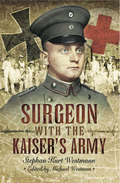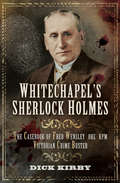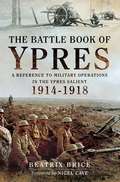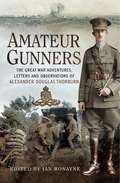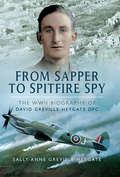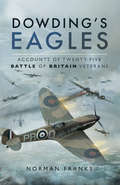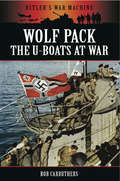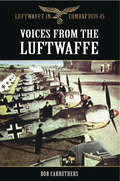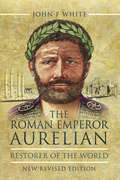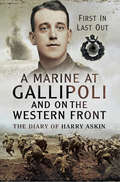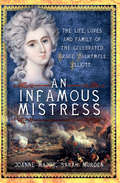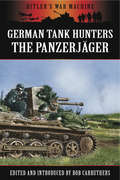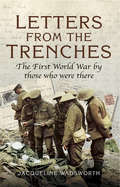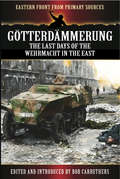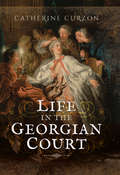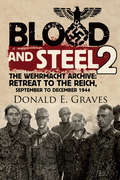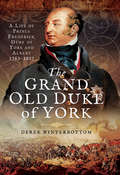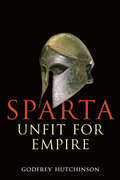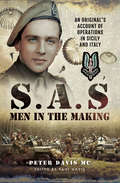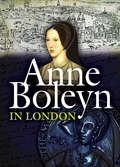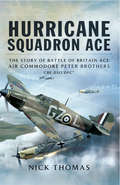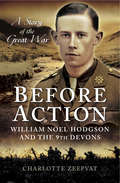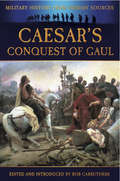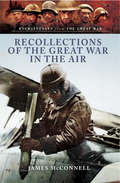- Table View
- List View
Surgeon with the Kaiser's Army
by Stephen Kurt WestmannThe Author gave up his medical studies at Freiburg University in 1914 to enlist in the German Army. He was soon involved in bloody hand-to-hand fighting against the French before moving to the Russian front.Promoted to medical officer, despite being unqualified and barely into his twenties he is given command of an ambulance train on the Western Front. He treats and operates on wounded of all nationalities and ranks and rescues British and German soldiers after gas attacks on the trenches of the Somme. As medical officer to the German Air Force (von Richthofen Circus) Westmann sees the dangers and effects of aerial combat at first hand. He witnesses the British tank attacks at Cambrai.His writing graphically illustrates life and death in the front line, the carnage and humour that sustained soldiers of all nationalities. Westmann's insights into the social, political, religious, economic and medical aspects of war time life are particularly revealing.The text is enhanced by contemporary photographs.
Whitechapel's Sherlock Holmes: The Casebook of Fred Wensley OBE KPM, Victorian Crime Buster
by Dick KirbyJack the Ripper and beyond—forty-one years in the investigative career of a man hailed by many as Scotland Yard&’s greatest detective of all time. Fred Wensley was a Somerset gardener when he joined the Metropolitan Police in 1888. His first case was to unmask Jack the Ripper. At least it familiarized Wensley with Whitechapel, where he bided his time collaring less threatening ne&’er-do-wells. After joining the CID, Wensley&’s career was a succession of triumphs. He brought to book the Bessarabian, Odessa, and Vendetta crime syndicates of London&’s East End; he played an instrumental role in smashing Latvian revolutionaries in the notorious Siege of Sidney Street; he formed the Flying Squad, a stealth surveillance team still operating to this day; and most infamous of all—his arrest in one of Great Britain&’s most notorious crimes of passion, a controversial cause célèbre that would shadow Wensley for the rest of his life. Retired Flying Squad officer Dick Kirby has dug deep to paint a fascinating portrait of Fred Wensley, Chief Constable of the CID and the first recipient of the King&’s Police Medal, in this &“welcome biography of a distinguished detective&” (History by the Yard).
The Battle Book of Ypres: A Reference to Military Operations in the Ypres Salient 1914–1918
by Beatrix BriceOf the many hard-fought battles on the Western Front, Ypres stands out as an example of almost inhuman endeavour. For four long years it was the focal point of desperate fighting. Officially there were four main battles in 1914, 1915, 1917 and 1918; these were more accurately peaks in a continuing struggle, for Ypres symbolised Belgian defiance, and the British continued to expend disproportionate resources on defending it. It never fell, although the Germans came close to its gates, and indeed its loss would have been a severe blow to morale.The Battle Book of Ypres, originally published in 1927 and now presented again as a special Centenary Edition, comprises a chronological account of the fighting in the Ypres Salient during the First World War, followed by a useful and unique alphabetical reference to the events in and around each hamlet, village or wood names familiar to those who fought or followed the course of war all those years ago, names now once again lost in insignificance. The names given to each stage of the struggle by the Battle Nomenclature Committee are listed in the appendix. Also included is an index of formations and units, an annotated bibliography and a new Foreword by military historian Nigel Cave.
Amateur Gunners: The Great War Adventures, Letters and Observations of Alexander Douglas Thorburn
by Ian RonayneAfter training at St John's Wood in London and in Exeter, Alexander Douglas Thorburn was posted to the BEF in France, joining the 2/22nd London (Howitzer) Battery, Royal Field Artillery as a subaltern officer. After service in the Vimy Ridge sector, with his division, the 60th (2/2nd London) Division, he crossed the Mediterranean to join the British Army in Salonika. Following a further move in mid-1917, Thorburn arrived in Palestine where he saw service with the 74th (Yeomanry) Division during the advance on Jerusalem. A final move in 1918 took the now Captain Thorburn back to the Western Front to take part in the Advance to Victory during the closing months of the war. After the war, Thorburn wrote an account of his military service between 1916 and 1918, recording his experiences in France, Greece and Palestine as well as his initial training in England. He also wrote a series of observations on life as a gunner during the First World War. Both the account and observations were published as a book, Amateur Gunners, in 1933 by William Potter of Liverpool. Today, the book is out of print. In addition to the book, of which a small number of copies still exist of course, there are an extensive series of private letters written by Thorburn while on active service to his mother, father and other relatives. The letters are in the possession of Thorburn's only grandson. Together, the book and letters offer a fascinating insight into the life of a First World War artillery officer. Lucidly written in a candid style, Thorburn shows excellent observation, description and narration skills. While Amateur Gunners itself is worthy of reprint, when combined with Thorburn's private letters and historical context from author Ian Ronayne, this book offers a unique look at a gunner's experience during the Great War.
From Sapper to Spitfire Spy: The WWII Biography of David Greville-Heygate DFC
by Sally-Anne Greville HeygateDavid Greville-Heygate was one of the few men who served in both the army and the Royal Air Force during the Second World War, but it was in the sky that he really earned his stripes. Stalking the skies flying photo-reconnaissance missions with No. 16 Squadron over Northern France, he was to win the illustrious and highly coveted Distinguished Flying Cross (DFC). Another highlight saw him in action in the skies above the French coastline in preparation for the D-Day landings, taking photographs that would provide the allies with essential intelligence upon which to base their plans. Based in Holland in December 1944, David flew armed recces with No.168 Squadron then transferred to No.2 Squadron where he reported on troop movements behind German lines. During the course of a dynamic and eventful career, he flew a wide variety of iconic wartime aircraft including Lysanders, Mustangs, Typhoons and Spitfires in England, the Netherlands and Germany.Although there have been many stories about the Battle of Britain there has been less published about the life of a photo reconnaissance pilot during this time. David's thrilling exploits in the sky and the part he played within the context of the wider war are enlivened here to great effect by his daughter, Sally-Anne Greville Heygate, herself a professional photographer. Using snippets from diary entries, letters, logbooks, squadron records and other documents, she has managed to construct an engaging history of a talented photo-reconnaissance pilot and the war in which he fought.
Dowding's Eagles: Accounts of Twenty-Five Battle of Britain Veterans
by Norman FranksTwenty-five veteran airmen share stories of their experiences during World War II’s Battle of Britain in this unique history.The Battle of Britain fought by The Few, as Churchill famously called them, will remain a legendary feat of arms for centuries to come. Sadly, there remain only a handful today who can tell their stories so this collection of personal accounts is extremely timely.The Author has over the years gathered the stories of twenty-five survivors and in Dowding’s Eagles he brings these stirring stories together. Each account describes the actions and impressions of the individuals who fought lonely battles against a numerically superior enemy. The odds were stacked against The Few.Over 500 pilots were killed in action during the summer of 1940, and this book is as much about those who gave their lives for their country as those who risked everything but managed to survive.Together with photographs of the men and their aircraft, this is an inspiring book.
Wolf Pack: The U-Boats at War (Hitler's War Machine)
by Bob Carruthers"Once you heard that pinging sound you knew they had got to you, then the depth charges came. Terrible, just terrible." Kurt Wehling, u-boat survivor The steel coffins was the name given to the U-boats of the Kriegsmarine by their own crews. Their fatalistic view of the war was certainly justified; it is estimated that seventy-five per cent of the 39,000 men who sailed in the U-boat fleet paid the ultimate price as the tide of war turned inexorably against Hitler's Germany. This is the illustrated history of the U-boat war from the perspective of the men who sailed into battle in the service of the Third Reich. Drawing heavily on the accounts of the last remaining survivors, 'The U-boat War' traces the grim story of the rise and fall of the grey wolves. The memories of the brief days of the "happy times" of superiority and success were soon replaced by the stark terror of the enfolding nightmare as the realisation dawned that the hunters had become the hunted. Written by Emmy award winning author Bob Carruthers, this powerful account of the U-boat war features extensive personal recollections, rare photographs and extracts from contemporary propaganda magazines producing a vivid picture of what it meant to fight beneath the waves.
Voices from the Luftwaffe (Luftwaffe in Combat 1939–45)
by Bob CarruthersThis WWII oral history tells the story of the Luftwaffe through the eyes of those who served in combat—illustrated with wartime propaganda. Drawing on extensive interviews with Luftwaffe, Emmy Award–winning historian Bob Carruthers traces its rise from the ashes of the Great War to its fearsome height and ultimate downfall. Here are the personal memories and perspectives of young volunteers seeking adventure who would soon face the grim realities of their service. Here too is the propaganda machine that glorified the Nazi cause and perpetuated the charade that this was a civilian undertaking. With vivid detail and revealing candor, readers experience how the stunning successes of the Blitzkrieg era are quickly overshadowed by the grim experiences of the Battle of Britain and the life-or-death fight for the skies over Germany. The book is illustrated throughout with extensive selections from Der Adler, the wartime Luftwaffe propaganda magazine.
The Roman Emperor Aurelian: Restorer of the World
by John F. WhiteThe leader who helped keep the Dark Ages at bay: &“An excellent picture of the Crisis of the Third Century and the life and work of Aurelian&” (StrategyPage). The ancient Sibylline prophecies had foretold that the Roman Empire would last for one thousand years. As the time for the expected dissolution approached in the middle of the third century AD, the empire was lapsing into chaos, with seemingly interminable civil wars over the imperial succession. The western empire had seceded under a rebel emperor, and the eastern empire was controlled by another usurper. Barbarians took advantage of the anarchy to kill and plunder all over the provinces. Yet within the space of just five years, the general, and later emperor, Aurelian had expelled all the barbarians from within the Roman frontiers, reunited the entire empire, and inaugurated major reforms of the currency, pagan religion, and civil administration. His accomplishments have been hailed by classical scholars as those of a superman, yet Aurelian himself remains little known to a wider audience. His achievements enabled the Roman Empire to survive for another two centuries, ensuring a lasting legacy of Roman civilization for the successor European states. Without Aurelian, the Dark Ages would probably have lasted centuries longer.
A Marine at Gallipoli on the Western Front: First In, Last Out: The Diary of Harry Askin
by Harry AskinHarry Askin was 22 when he enlisted at Nottingham in September 1914 and was sent to train with the Royal Marines at Portsmouth.He set sail with the Mediterranean Expeditionary Force in late February 1915. On 25 April he was towed ashore to Gallipoli. So began a nine month ordeal of constant fighting and shelling on that bare and desperate Peninsula.In this diary he captures the atmosphere of danger and death, blazing heat in summer and rain and cold at other times. The smell of dead bodies was everywhere and while the fortitude of the troops was astonishing, at times confusion and panic prevailed. Harry was wounded twice in one day but the surgeon removed the bullet and he returned to the firing line.Harry was among the last to withdraw and his reward was to be sent to the Western Front. Again he was wounded. This is a stirring memoir which paints a vivid picture of the horrors of war.
An Infamous Mistress: The Life, Loves and Family of the Celebrated Grace Dalrymple Elliott
by Joanne Major Sarah Murden&“Courtesan. Spy. Survivor. A gripping and meticulously researched account of the swashbuckling life of one of history&’s most overlooked heroines.&” —Hallie Rubenhold, author of The Five Divorced wife, infamous mistress, prisoner in France during the French Revolution, and the reputed mother of the Prince of Wales&’ child, notorious courtesan Grace Dalrymple Elliott lived an amazing life in eighteenth- and early nineteenth-century London and Paris. Strikingly tall and beautiful, later lampooned as &“Dally the Tall&” in newspaper gossip columns, she left her Scottish roots and convent education behind to reinvent herself in a &“marriage à-la-mode,&” but before she was even legally an adult she was cast off and forced to survive on just her beauty and wits. The authors of this engaging and, at times, scandalous book intersperse the story of Grace&’s tumultuous life with a family history that traces her ancestors from their origin in the Scottish borders, to their move south to London. It follows them to France, America, India, Africa, and elsewhere, offering a broad insight into the social history of the Georgian era, comprising the ups and downs, the highs and lows of life at that time. &“A fascinating read . . . a shining example of research done well, presented coherently on the perfect subject: a powerful courtesan that time forgot.&” —History of Royals &“Set for the first time in the context of Grace&’s wider family, this is a compelling tale of scandal and intrigue.&” —Scots Heritage Magazine
German Tank Hunters: The Panzerjäger (Hitler's War Machine)
by Bob CarruthersThis unique collection of contemporary combat accounts provides a primary source insight into the reality of anti-tank warfare on the Eastern Front. Both armoured and infantry based operations are considered.This book is part of the 'Hitler's War Machine' series, a new military history range compiled and edited by Emmy Award winning author and historian Bob Carruthers. The series draws on primary sources and contemporary documents to provide a new insight into the true nature of Hitler's Wehrmacht.The series consultant is David Mcwhinnie creator of the award winning PBS series 'Battlefield'.
Escaping from the Kaiser: The Dramatic Experiences of a Tommy POW
by H. W. TustinOnly a week after joining the 8th Durhams in April 1915 Private Herbert Tustin was captured at the Battle of Ypres. He describes the horror of trench warfare, his treatment on being taken a POW and the three day train journey into Germany.There followed 16 months captivity at Rennbahn POW Camp with its hunger, hardships, brutality, work regime, friendships, humour and the different national characteristics of fellow POWs.In late summer 1916 together with a Canadian POW, Gerrie Burk, the author escaped over the wire. For the next 10 days travelling by night, sleeping rough and stealing basic food they headed for Holland. Somehow they miraculously managed to avoid re-capture despite the closest of calls. Once on the Dutch coast they found a boat, SS Grenadier to carry them across the mine-strewn, submarine infested North Sea to England, arriving on 18 September.This amazing story of war, imprisonment, escape and survival concludes with the author's wife recalling the hero's welcome home, the joyful reunion and his proposal of marriage.
Letters from the Trenches: The First World War by Those Who Were There
by Jacqueline WadsworthA history of World War I—told through the letters exchanged by ordinary soldiers and their families. Letters from the Trenches reveals how people really thought and felt during the Great War, and covers all social classes and groups from officers to conscripts to women at home to conscientious objectors. Voices within the book include Sgt. John Adams, 9th Royal Irish Fusiliers, who wrote in May 1917: &“For the day we get our letter from home is a red letter day in the history of the soldier out here. It is the only way we can hear what is going on. The slender thread between us and the homeland.&” Pvt. Stanley Goodhead, who served with one of the Manchester Pals battalion, wrote home in 1916: &“I came out of the trenches last night after being in four days. You have no idea what four days in the trenches means . . . The whole time I was in I had only about two hours sleep and that was in snatches on the firing step. What dugouts there are, are flooded with mud and water up to the knees and the rats hold swimming galas in them . . . We are literally caked with brown mud and it is in all our food, tea etc.&” Jacqueline Wadsworth skillfully uses these letters to tell the human story of the First World War: what mattered to Britain&’s servicemen and their feelings about the war; how the conflict changed people; and how life continued on the home front.
Götterdämmerung: The Last Days of the Wehrmacht in the East (Eastern Front From Primary Sources Ser.)
by Bob CarruthersThis fascinating collection of primary source accounts focuses on the combat actions of the Wehrmacht in the final battles of the war. The material is drawn from a variety of wartime sources and encompasses fascinating writings concerning the tactical, operational and strategic aspects of the battle for Berlin. Compiled and edited by Emmy Award winning author and historian Bob Carruthers, this absorbing assembly of primary source intelligence reports encompasses rare material originally drawn from both German and Russian original sources to provide the reader with a unique insight into the last battles in the east. This is the unvarnished reality of what it meant to fight in this titanic struggle to the death.Featured in the book are reports concerning little known and neglected tactical aspects of the war including weapons, street fighting techniques and improvised anti-tank measures. Original illustrations from US wartime intelligence manuals are also featured. This compelling compilation is essential for readers with an interest in discovering more about the last days of the Wehrmacht from a range of unusual and diverse primary sources.
Life in the Georgian Court
by Catherine CurzonThis lively history of Europe&’s royal families through the 18th and early 19th centuries reveals the decadence and danger of court life. As the glittering Hanoverian court gives birth to the British Georgian era, a golden age of royalty dawns in Europe. Houses rise and fall, births, marriages and scandals change the course of history. Meanwhile, in France, Revolution stalks the land. Life in the Georgian Court pulls back the curtain on the opulent court of the doomed Bourbons, the absolutist powerhouse of Romanov Russia, and the epoch-defining royal family whose kings gave their name to the era, the House of Hanover. Beneath the powdered wigs and robes of state were real people living lives of romance, tragedy, intrigue and eccentricity. Historian Catherine Curzon reveals the private lives of these very public figures, vividly recounting the arranged marriages that turned to love or hate and the scandals that rocked polite society. Here the former wife of a king spends three decades in lonely captivity, King George IV makes scandalous eyes at the toast of the London stage, and Marie Antoinette begins her final journey through Paris as her son sits alone in a forgotten prison cell.Life in the Georgian Court is a privileged peek into the glamorous, tragic and iconic courts of the Georgian world, where even a king could take nothing for granted.
Blood and Steel 2: The Wehrmacht Archive: Retreat to the Reich, September to December 1944
by Donald E. GravesOverwhelmed by the strength of the Allied air and ground forces, following the D-Day landings and subsequent bitter fighting in Normandy, the Germans were compelled to abandon their efforts to hold France and much of the Low Countries and retreat to the Rhine.The Wehrmacht Archive helps reveal the experience of German soldiers and armed forces personnel as they withdrew through a remarkable collection of translated original orders, diaries, letters, after-action reports and other documentation. The book also draws upon Allied technical evaluations of weapons, vehicles and equipment, as well as transcripts of prisoner of war interrogations. The reader will learn from official documents about the Germans' efforts to cope with Allied air and artillery superiority, create new tactical methods for all arms and maintain discipline in the face of superior numbers.
The Grand Old Duke of York: A Life of Prince Frederick, Duke of York and Albany 1763–1827
by Derek Winterbottom&“A modern look at HRH the Duke of York . . . a nice addition to Napoleonic Era history&” from the historian and author of The Mighty Montagus (The Napoleon Series Reviews). Oh, the grand old Duke of York, He had ten thousand men; He marched them up to the top of the hill, And he marched them down again. And when they were up, they were up, And when they were down, they were down, And when they were only half-way up, They were neither up nor down. Prince Frederick, Duke of York and Albany is famous because of the nursery rhyme which ridicules him for poor leadership but, as Derek Winterbottom&’s biography shows, he was far from incompetent as a commander. What is more, the famous rhyme does not even hint at his achievements as commander-in-chief of the British army during the Napoleonic Wars. His career as a commander and administrator and his scandalous private life are long overdue for reassessment, and that is what this perceptive and absorbing study provides. He transformed the British military machine, and the Duke of Wellington admitted that without York&’s reforms he would not have had the army that fought so well in the Peninsular War and at Waterloo. York also led a turbulent personal life which was engulfed by scandal when his mistress was accused of using her influence over him to obtain promotion for ambitious officers. Today the Duke of York is a neglected, often derided figure. This biography should go some way towards restoring his reputation as a commander and military reformer. &“This is an excellent, readable biography of a major but somewhat neglected historical figure.&” —History of War
Sparta: Unfit For Empire
by Godfrey HutchinsonThe end of the Peloponnesian War saw Sparta emerge as the dominant power in the Greek world. Had she used this position wisely her hegemony might have been secure. As it was, she embarked on actions that her former allies, Thebes and Korinth, refused to support. The rise of Thebes as a threatening power to Sparta's control of Greece was largely the result of the brilliant exploits of Epaminondas and Pelopidas whose obvious examination of Spartan tactics allowed them to provide counters to them. While noting the political issues, Godfrey Hutchinson's focus is upon the strategic and tactical elements of warfare in a period almost wholly coinciding with the reign of the brilliant commander, Agesilaos, one of the joint kings of Sparta, who, astonishingly, campaigned successfully into his eighties.
S.A.S Men in the Making: An Original's Account of Operations in Sicily and Italy
by Peter DavisPeter Davis was the youngest officer in the SAS during World War II. In his autobiographical account, he reveals the nave enthusiasm he felt when he joined the Unit, his fears and trepidation during training, and the horror at what he later experienced during his first operations in the liberation of Sicily and Italy. This is his story.It explores the difficulty of a young, inexperienced officer leading older and seasoned soldiers. It tells of mistakes a 'rookie' can make and of how listening, learning and ultimately earning respect made him the skilful leader he ultimately became. During later operations he was awarded the Military Cross.Through it all the enigmatic figure of Paddy Mayne looms large. At times irrational, aggressive, and often drunk, he was always a born leader able to instil obedience and respect. Where he led, men followed.This autobiographical account was written shortly after the end of the War, using diaries written at the time. It is possibly the last, untold, first-hand account of a time of chaos, of horror and of the camaraderie of the men of the SAS.
Anne Boleyn in London
by Lissa ChapmanA portrait of the doomed queen&’s image and influence that provides &“a detailed look at real life in Tudor England&” (Manhattan Book Review). Romantic victim? Ruthless other woman? Innocent pawn? Religious reformer? Fool, flirt, and adulteress? Politician? Witch? During her life, Anne Boleyn, Henry VIII&’s ill-fated second queen, was internationally famous—or notorious. Today, she still attracts passionate adherents and furious detractors. It was in London that most of the drama of Anne Boleyn&’s life and death was played out, most famously in the Tower of London, the scene of her coronation celebrations, her trial, and her execution, and the place where her body lies buried. In her few years as a public figure, Anne Boleyn was influential as a patron of the arts and of French taste, as the center of a religious and intellectual circle, and for her purchasing power, both directly and as a leader of fashion. It was primarily to London, beyond the immediate circle of the court, that her carefully spun image as queen was directed during the public celebrations surrounding her coronation. In the centuries since Anne Boleyn&’s death, her reputation has expanded to give her an almost mythical status in London, inspiring everything from pub names to music hall songs and novels—not to mention merchandise including pincushions with removable heads. Over fifty Twitter accounts use some version of her name. This book looks at both the effect London and its people had on the course of Anne Boleyn&’s life and death—and the effects she had, and continues to have, on them.
Hurricane Squadron Ace: The Story of Battle of Britain Ace, Air Commodore Peter Brothers, CBE, DSO, DFC and Bar
by Nick Thomas“The story of one of the most heroic fighter aces of the Second World War . . . has been brought to life in this gripping new book.” —Lancashire Living MagazineAir Commodore Peter Malam “Pete” Brothers CBE, DSO, DFC, and Bar (1917-2008) was one of the most highly praised pilots of the Second World War. Decorated extensively, he secured a total of 16 “kills” over the course of the conflict, with 10 of these occurring during the Battle of Britain. Pivotal moments in his career include the time, in August 1940, when his flight encountered around a hundred enemy aircraft, including Messerschmitt 110s; he led the flight in attack against them, and soon found himself in a stalled position, out of which he spun, only to be confronted by a Dornier 215, which he shot down, before later destroying a Messerschmitt 109. Scores of these kind of risky maneuvers and winning victories punctuated a career defined by great courage, leadership and initiative in the face of fierce opposition. This new and engaging biography profiles a pilot who, until now, hasn’t been the subject of such a thorough book-length study. The story of his career is incredibly entertaining, featuring a number of hair-raising episodes, and is sure to appeal to fans of aviation history as well as the more general reader seeking out an action-packed biography offering fresh insights into one of the most pivotal conflicts of the twentieth century.“An engaging story of one of The Few . . . This is a book that entertains, inspires, moves, amuses, surprises—what more could any reader ask for.” —FIRE Project
Before Action: William Noel Hodgdon and the 9th Devons, A Story of the Great War
by Charlotte ZeepvatWilliam Noel Hodgson never intended to be a soldier; he wanted to write. The Great War made his reputation as a poet but it also killed him. This groundbreaking biography traces his path through the pre-war world and explores why he set his own hopes and plans aside to join the army. His story is personal but it evokes the experience of a generation.A hundred years on, Hodgson is not only remembered for his poetry. He has become one of the best-known casualties of the first day of the Battle of the Somme, the most deadly day in British military history. His own unit, the 9th Battalion, The Devonshire Regiment, lost well over half the men who went over the top that morning and every officer but one: dead, wounded or missing, most in the first half-hour.Before Action draws on Hodgsons own writing and on the unpublished letters and diaries of his fellow officers to recreate the experiences of a 1914 volunteer battalion. Through their eyes we see everything from the lighter moments of soldiering to battle at its most violent: at Loos, where Hodgson won the Military Cross, and the opening day of the Somme offensive. The book offers an important new explanation of what happened to the 9th Devons that fateful morning. It uncovers the hidden meanings behind some of Hodgsons most familiar poems, and its wider themes of family and friendship, war, grief and remembrance, are universal.
Caesar's Conquest of Gaul: The Illustrated Edition (Military History from Primary Sources)
by Bob CarruthersThe Gallic Wars were a series of military campaigns waged by the Roman proconsul Julius Caesar against several Gallic tribes. They lasted from 58 BC to 50 BC and culminated in the decisive Battle of Alesia in 52 BC, in which a complete Roman victory resulted in the expansion of the Roman Republic over the whole of Gaul. The wars paved the way for Julius Caesar to become the sole ruler of the Roman Republic.Although Caesar portrayed this invasion as being a preemptive and defensive action, most historians agree that the wars were fought primarily to boost Caesar's political career and to pay off his massive debts. Still, Gaul was of significant military importance to the Romans, as these had been attacked several times by native tribes both indigenous to Gaul and further to the north. Conquering Gaul allowed Rome to secure the natural border of the river Rhine.The Gallic Wars are described by Julius Caesar as himself in this book, which was originally titled Commentarii de Bello Gallico, it is a pertinent and only slightly tendentious and altogether the most important historical source regarding the conflict. This updated edition contains the translated text and various illustrations depicting Roman warfare and key moments in Caesar's journey.
Recollections of the Great War in the Air: Recollections Of The Great War In The Air (Eyewitnesses from The Great War)
by James McConnell&“The memoir of . . . an American pilot flying with the famous French Flying Corps&’ American Layfayette Escadrille and provides a unique personal insight.&”—Firetrench In 1915 James Roger McConnell enlisted as a US volunteer in the French Flying Corps. He was part of a remarkable band of American volunteers which were formed into the famous Lafayette Escadrille, which was then based at Verdun. This book brings his personal account of the war, Flying for France, to a new generation of readers. His memoirs produce an amazing insight into the early aerial battles and trace the evolution of aerial warfare as the rickety aircraft of 1915 rapidly evolved into the purpose-built fighters of 1917. Casualties among the American Escadrille were very high and McConnell&’s own luck finally ran out when he was ambushed by two German fighters and was killed in action in March 1917. His gripping and detailed memoir of the war is his lasting memorial; his honest account of the everyday life of a pilot in the Great War is matched only by Sagittarius Rising. However, his dramatic description of the battlefield of Verdun viewed from above is one of the classic descriptions of any wartime memoir and is unmatched by any other Great War writer. &“Resurrects an important part of the first-person literature of the Lafayette Escadrille. A long-lost gem.&”—Over the Front &“The memoir and letters give a surprising amount of detail about the pilot&’s life and tactics employed. McConnell&’s story is certainly an interesting one and this is a short and easily digestible introduction to the life of a First World War pilot.&”—WW1 Geek
